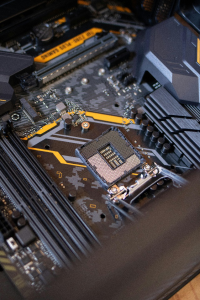If you’ve spent any significant amount of time with a computer, you’ve likely encountered the dreaded Blue Screen of Death (BSOD). This sudden and alarming error can send even the most seasoned users into a panic. Fear not! This guide will help you understand what causes the BSOD and how to recover from it.
Understanding the Blue Screen of Death
The Blue Screen of Death appears when Windows encounters a critical error it can’t recover from, leading to a system crash. This crash is often triggered by hardware failures, corrupted drivers, or incompatible software. The screen typically displays an error code, which can provide clues about the underlying issue.
Common Causes of the BSOD
Here are some common reasons why you might see the Blue Screen of Death:
Driver Issues
Corrupted or outdated drivers are a common cause of system crashes. Updating these drivers or reinstalling them can often resolve the problem.
Hardware Failures
Faulty hardware components, like RAM or hard drives, can trigger a BSOD. Checking and replacing defective parts is essential.
Software Conflicts
Sometimes, newly installed software can be incompatible with existing system files, leading to a crash.
Troubleshooting Tips for the Blue Screen of Death
When encountering a BSOD, there’s more to troubleshooting than just rebooting. Here are some additional unique tips to help you diagnose and resolve the problem:

Check Event Viewer
Windows maintains an Event Viewer log that records system errors and other significant events. Reviewing this log can help you pinpoint the root cause of the BSOD. Look for error messages or warnings that occurred just before the crash.
Boot into Safe Mode
Safe Mode allows Windows to start with minimal drivers and software, reducing the likelihood of a crash. If the system boots successfully in Safe Mode, you can eliminate hardware as the cause and focus on identifying problematic software or drivers.
Run Hardware Diagnostics
Many computer manufacturers provide built-in hardware diagnostic tools. Use these utilities to test your hardware, such as RAM, hard drives, and CPU, to identify any faulty components.
Update Windows
Keeping your operating system updated is crucial. Sometimes, system crashes occur due to outdated or missing Windows updates. Check for updates and install them to ensure your system has the latest patches and security fixes.
Scan for Malware
Malware can cause a BSOD by corrupting system files or interfering with critical processes. Run a thorough antivirus scan to ensure your system is free from malicious software.
Identifying BSOD Error Codes
Each Blue Screen of Death displays an error code that provides information about the underlying problem. Understanding these codes can help you narrow down the cause:
DRIVER_IRQL_NOT_LESS_OR_EQUAL
Indicates a problem with a specific driver. Try updating or reinstalling drivers to resolve this issue.

PAGE_FAULT_IN_NONPAGED_AREA
Suggests an error with memory allocation. Check your RAM and virtual memory settings.
KERNEL_SECURITY_CHECK_FAILURE
This code often points to issues with system security. Ensure your antivirus software is up to date and perform a system scan.
SYSTEM_SERVICE_EXCEPTION
Typically related to software conflicts. Try uninstalling recently added software or performing a system restore.
Steps to Overcome the Blue Screen of Death
When you encounter the BSOD, follow these steps to address the issue and get your computer back up and running:
Reboot the Computer
A simple restart can sometimes fix minor glitches. However, if the problem persists, proceed to the next step.
Check for Hardware Issues
If you’ve recently added new hardware, remove it and see if the problem resolves. For existing hardware, perform diagnostics to identify any faulty components.

Update Drivers
Outdated drivers can cause system instability. Visit your hardware manufacturer’s website to download and install the latest drivers.
Uninstall Problematic Software
If the BSOD occurs after installing new software, try uninstalling it. This can resolve software conflicts.
Perform a System Restore
Windows has a built-in System Restore feature that allows you to revert your computer to an earlier state before the problem occurred.
Seek Professional Help
If the BSOD persists, it’s time to contact a professional. Emergency computer repair services like those offered by Princeton Computer Repair Service are equipped to handle complex issues.
Preventing Future BSODs
To avoid future crashes, take these preventive measures:
Regular Maintenance
Keep your system clean and updated. Perform regular virus scans, update software, and clear out unnecessary files.

Install a Reliable Antivirus
Viruses and malware can cause system instability. Ensure you have a reputable antivirus program installed.
Back Up Your Data
Always keep backups of important files to prevent data loss in case of a BSOD or other critical failure.
When to Seek Professional Help
While many BSOD issues can be resolved with basic troubleshooting, some problems require professional assistance. Consider reaching out to a computer technician princeton if:
The BSOD Occurs Frequently
If you experience recurring crashes, it indicates a deeper issue that requires expert attention.
You’re Not Sure What to Do
If you’re unsure how to diagnose or resolve the problem, seeking professional help can save you time and frustration.
You’re Concerned About Data Loss
If your system contains critical data and you don’t have backups, it’s best to let professionals handle the repairs to avoid further complications.

The Blue Screen of Death can be frightening, but with the right steps, you can overcome it and get your system running smoothly again. If you need assistance, professionals at Princeton Computer Repair Service can help. We specialize in emergency computer repair, software installation, laptop repair, and more. Our experts can help you recover from a Blue Screen of Death and ensure your system is stable and reliable.
Need Help With BSOD? Get in Touch with Princeton Computer Repair Service
Facing a Blue Screen of Death or system freeze? At Princeton Computer Repair Service, we specialize in emergency computer repair, software installation, and laptop repair. Our experts can quickly identify and fix hardware, software, and driver issues that cause system failures.
Contact us today!Top of Form
